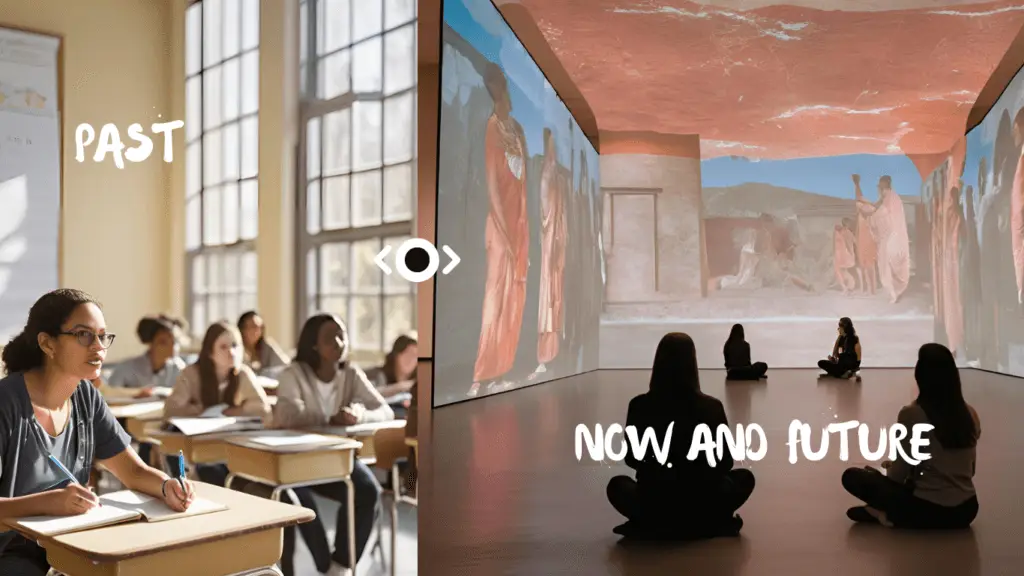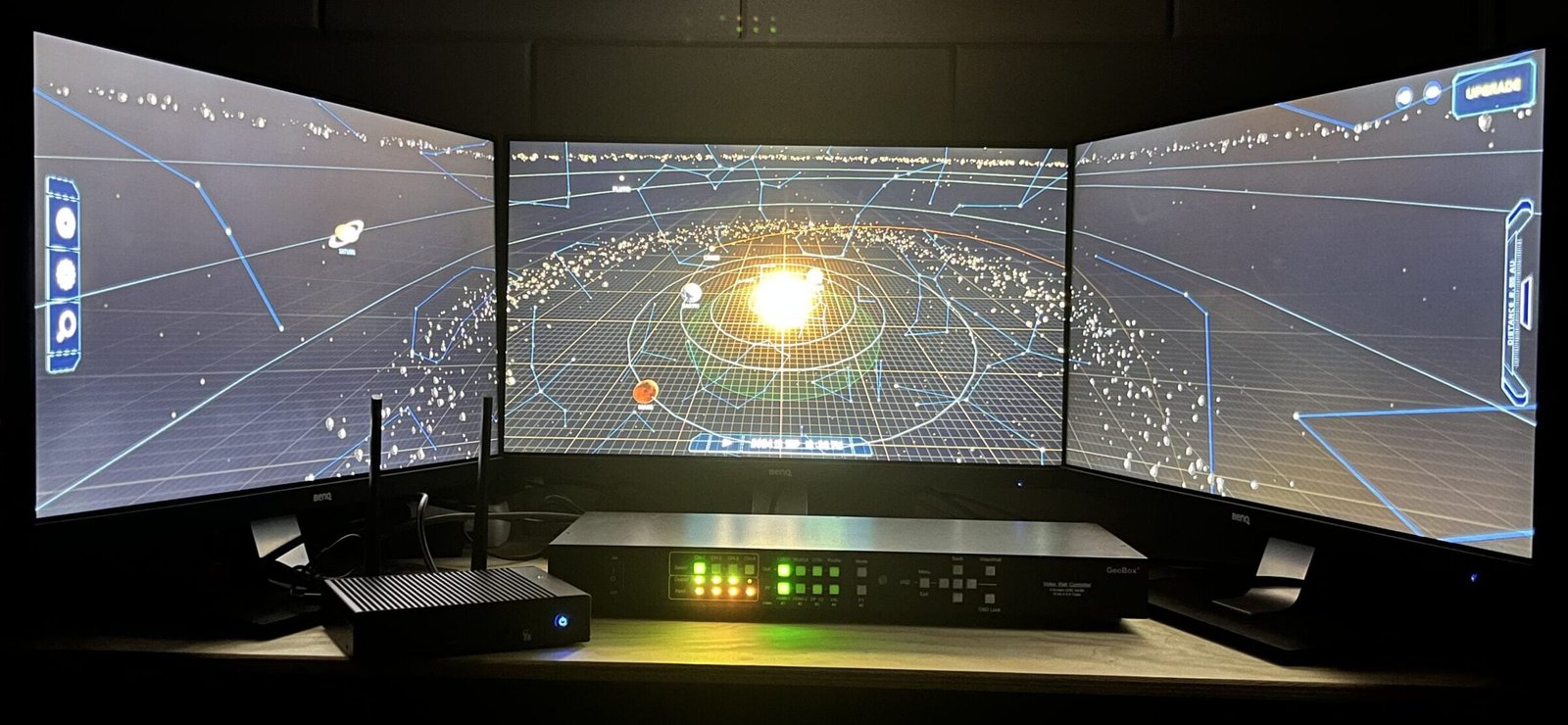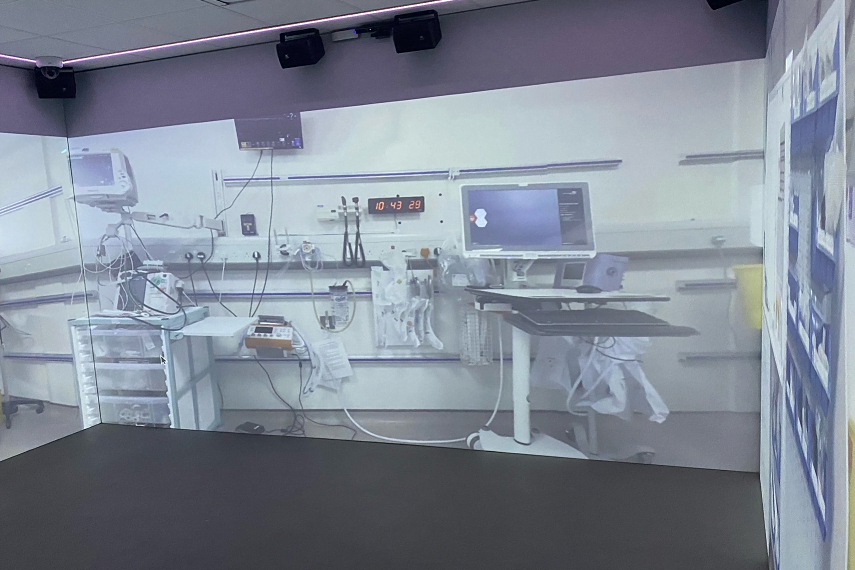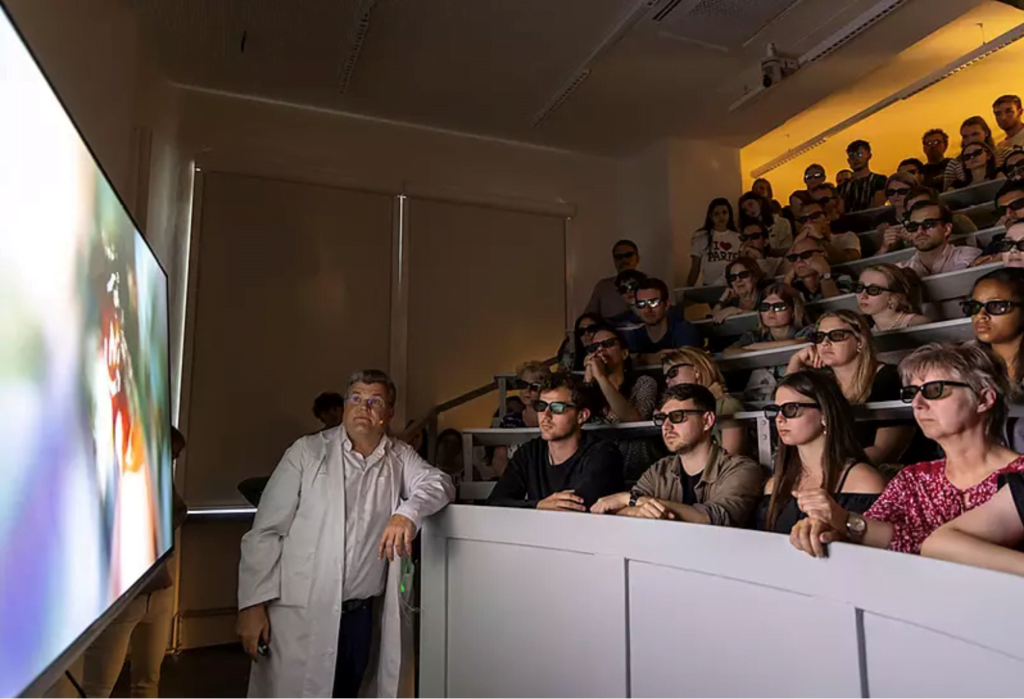-
Case Studies
-
- Rediscovering the Skies: Flight Simulator Brought to Life with GeoBox Technology
- Unlocking the Future of Learning
- Projection Based Immersive Learning: NOW and The Future of Education and Training
- GeoBox Unveiling the Future of Neurosurgery with 3D Technology: Interview Professor Wolfsberger (Austria)
- Creating large projection in School Theater for multiple purposes (Netherlands)
- Secta Immersive Enhances Trainings in Immersive Rooms with GeoBox
-
- GeoBox and Panasonic Projectors Immersify Kuala Lumpur
- Elevating Immersive Art to New Heights: GeoBox in Hyundai Futurenet’s Le Space
- Immersive Multimedia Installation at Museo del Lago – Montemurro (Italy)
- Digital art for Karuizawa New Art Museum's special exhibition"Irreplaceable Things - Earth, Landscape, and Environment"
- How To Enhance Museum Visual Experience with Immersive Projection Technology
- Museums in the Digital Era: Tackling Challenges and Learning from Teylers Museum (NL)
- GeoBox Enhancing Historical Landmarks with Immersion: Fort Victor Emmanuel (France)
- A Journey into Immersive Aquarium: The Deep (Hull, UK)
- 125 years BOSCH in the UK: Powered by GeoBox and Panasonic
- Immortalizing Media Heritage In the Media Museum (Hilversum, NL)
- Media museum Sound & Vision in the Netherlands
- Dive Into History with Geobox (Brugge, Belgium)
- Immersive projection installation in Switzerland
- GeoBox support Slovakia Pavilion in EXPO2020
- Experience F-16 at National Military Museum (Soest, Netherlands)
- Mori Building Digital Art Museum: Epson teamLab Borderless
- The 10th annual Korea Gyeongju World Culture Expo
- Projection mapping for museum
- GeoBox recreates the Fifth Aztec Sun at Stuttgart’s Linden Museum
- Discovering the image control solution behind Digital Art Museum
- Show all articles (5) Collapse Articles
-
- Esports AV Integration at Its Best: GeoBox Powers the ZOWIE Gaming Experience Center
- Elevating Immersive Art to New Heights: GeoBox in Hyundai Futurenet’s Le Space
- GeoBox Transforms Interior Design through Immersive Technology (Andalusia, Spain)
- Lifesize Plans - Revolutionizing Architectural Visualization
- Immersive Fusion: The Technological Creativities of Ragdale Hall Spa's Thought Zone
- Illuminating Hope: The Hanbit Tower Christmas Project of (Korea, 2020)
- GeoBox Projection Mapping in Japan Kyoto Kodai-ji Temple
- Elevating the Shopping Experience: IKEA's Immersive Technology in the Heart of Paris (France)
- 125 years BOSCH in the UK: Powered by GeoBox and Panasonic
- Sony Professional Display at OMR 2023 (Hamburg, Germany)
- The Holodeck: A Futuristic Meeting Space
- How G413 elevate guest experience at the luxurious Andreus Resorts
- Immersion in Yoga studio
- GeoBox adds edge-blending interaction to Vodafone’s flagship store in Netherland
-
-
Technical Articles
-
- MSFS 2024 Meets GeoBox M813: The Ultimate Guide to Immersive Flight Simulation
- How to use ChromeBox for Immersive display
- How To Enhance Museum Visual Experience with Immersive Projection Technology
- S902, Improve the effectiveness of your large display system
- Simplify your content preparation workflow with GeoBox
- A Guide for Effortless Immersive Experience Setup in 5 Minutes
- The Synergy of Using BrightSign Player with GeoBox video Controller
- Seamless Edge Blending: GeoBox's Black Level Uplift Solution for AV Professionals
- GeoBox New 810 Series: Elevating Pro AV Excellence
- Synergy of Digital Signage Player and Video Controller
- HDMI Technologies and Cables: A Guide for Professional AV Technicians
- Unveil GeoBox mini edge blending and warping box: G111 / G112
- The new range of All-In-One edge blending solutions - M810 series
- GeoBox in ISE2022
- G901, all-round multi-purpose controller: Multi-viewer, ultra-high resolution, 3D, Seamless switching & more..
- A better solution for your multi-projector edge blending project
- 8K input timing support in all GeoBox solutions
- How to display a large image using multiple projectors?
- Epson x GeoBox 8K/4K demo event
- 4K projectors edge blending and warping
- 4K projector edge blending, warping controller
- Immersive display solution
- How to plan for a large projection system?
- GeoBox G901 4K60hz input and output processor is now available in Europe
- Projection mapping for museum
- Projection mapping technology from GeoBox
- Edge blending calculator for multi-projector project planning
- Reliable Hardware-Based Video Processing for Professional AV Installations
- Show all articles (13) Collapse Articles
-
- How to use ChromeBox for Immersive display
- Digital art for Karuizawa New Art Museum's special exhibition"Irreplaceable Things - Earth, Landscape, and Environment"
- S902, Improve the effectiveness of your large display system
- Simplify your content preparation workflow with GeoBox
- The Synergy of Using BrightSign Player with GeoBox video Controller
- Synergy of Digital Signage Player and Video Controller
- HDMI Technologies and Cables: A Guide for Professional AV Technicians
- GeoBox in ISE2022
- G901, all-round multi-purpose controller: Multi-viewer, ultra-high resolution, 3D, Seamless switching & more..
- 8K input timing support in all GeoBox solutions
- 4K in-out Video wall controller with Multi-viewer - 'world first'
- Video wall controller: Top 5 reasons why using it
- GeoBox G901 4K60hz input and output processor is now available in Europe
-
News Letters
Projection Based Immersive Learning: NOW and The Future of Education and Training

It’s been almost 100 years since John Dewey (1859–1952) said, “If we teach today’s students as we taught yesterday’s, we rob them of tomorrow.” Dewey’s philosophy of education focused on active, student-centered learning that is relevant to the real world.
Now, technologies are blurring the lines between learning and the real world.
Today, educators and trainers are constantly striving to prepare students for the unknown challenges of tomorrow, the demand for innovative teaching methods is higher than ever. Picture a group of students gathered in a room, not just listening to a lecture, but fully immersed in a 360-degree reenactment of a historical event or navigating through the intricate details of a complex surgical procedure. This is the future of learning, and it’s happening NOW.
Welcome to the era of Projection-Based Immersive Learning, where cutting-edge projection technology transforms ordinary spaces into dynamic, interactive environments, making learning an unforgettable experience. In this article, we explore:
- How this groundbreaking approach is revolutionizing education and training,
- Why it’s poised to be a major trend and the unique benefits it brings,
- The technical challenges of creating these spaces, and
- How our GeoBox solution makes it easier than ever to bring this vision to life.
Whether you’re an educator, a decision-maker, or a forward-thinking professional, join us as we explore the future of learning.
Understanding Projection-Based Immersive Learning
Projection-Based Immersive Learning utilizes multiple projectors to create an all-encompassing visual and auditory environment, fully surrounding learners. Unlike traditional classrooms that rely on a single screen or whiteboard, immersive learning spaces project dynamic, interactive content on walls, floors, and even ceilings. This setup allows learners to step into a simulated world where they can interact with educational materials in a highly engaging and experiential manner.
For example, a history lesson might involve a 360-degree projection of an ancient archaeological site, enabling students to explore the area as if they were physically present. Similarly, in medical training, an immersive space could simulate a complex surgical procedure, offering trainees a hands-on experience that is both realistic and risk-free. This video is great example of immersive learning.
The Future of Education and Learning
Projection-Based Immersive Learning is not just a passing trend; it is poised to become a significant component of future education and training. Several factors contribute to this growing relevance:
- Advancements in Technology: With rapid improvements in projection technology, including higher resolution, brightness, and affordability, creating high-quality immersive spaces has become more feasible. Coupled with digital content advancements that render realistic 3D environments and integrate interactive elements, this technology is becoming increasingly accessible to educational institutions and training centers.
- Demand for Experiential Learning: Babies learn how to unlock mobile phones before they learn how to speak. Modern learners, especially younger generations, are increasingly drawn to experiential learning methods. Immersive environments cater to this demand by offering more engaging and memorable experiences than traditional methods.
- Enhanced Remote Learning: In a world where remote and hybrid learning models are now commonplace, projection-based immersive learning bridges the gap between physical and virtual classrooms. It creates shared spaces where students, regardless of their location, can immerse themselves in the same educational environment.
- Tailored and Adaptive Learning: As education becomes more personalized, immersive learning environments can be adapted to meet the specific needs of individual learners, providing customized experiences that are more effective in achieving educational outcomes.
Unique Benefits of Projection-Based Immersive Learning Spaces
Projection-Based Immersive Learning offers several distinct advantages:
- Enhanced Engagement: Immersive spaces captivate learners by placing them at the center of the action. This heightened engagement leads to better retention of information and a deeper understanding of complex concepts.
- Realistic Simulations: In fields like medicine, engineering, and aviation, realistic simulations are crucial for effective training. Immersive environments provide a safe yet realistic platform for learners to practice and hone their skills.
- Collaborative Learning: Immersive spaces encourage collaboration among learners. Teams can work together to solve problems in a shared virtual environment, fostering teamwork and communication skills.
- Multi-Sensory Learning: By engaging multiple senses, projection-based immersive learning accommodates various learning styles, making it a more inclusive approach. Visual, auditory, and kinesthetic learners can all benefit from the rich, multi-sensory experiences these environments offer.
- Emotional Impact: Immersive environments can evoke strong emotional responses, which can reinforce learning. For example, experiencing a historical event in an immersive setting can leave a lasting impression that a textbook alone cannot achieve.
Read the reference case of Immersive learning
Secta Immersive Enhances Trainings in Immersive Rooms with GeoBox
Read the reference case of 3D in medical learning
Overcoming the Technical Challenges
While the potential of projection-based immersive learning is vast, there are several technical challenges that must be addressed:
- Complexity of Setup: Creating a fully immersive space requires the precise calibration of multiple projectors to ensure seamless alignment and blending of images. This process can be technically challenging and time-consuming, often requiring specialized knowledge and equipment.
- Cost Considerations: The initial investment in high-quality projectors, screens, and other hardware can be significant. Additionally, the cost of maintaining and upgrading these systems must be factored into the overall budget.
- Content Creation: Developing content for immersive environments requires expertise not only in the subject matter but also in 3D modeling, animation, and interactive design. High-quality content is essential for the success of these learning environments.
- Space Requirements: Not all educational institutions or training centers have the physical space necessary to set up an immersive learning environment. Modifying existing spaces to accommodate this technology can be a significant hurdle.
- Technical Support and Training: Educators and trainers must be adequately trained to use and maintain the technology. Ongoing technical support is essential to ensure that the immersive environment remains functional and effective over time.
How GeoBox Simplifies the Creation of Immersive Learning Spaces
If you’re ready to transform your educational space into an immersive learning environment, GeoBox is the perfect solution to get you started.
When building an immersive learning space, three key components must be considered:
- Content and Content Player(s): These store and play content files, for example, PC, laptop, media players, or web-cam…etc. Depending on the setup, some people might want to swithc content from more than one devices or to show multiple contents on the wall.
- Video Processor: To display the content correctly in the desired area, a video processor is essential. This can be a software solution running on a PC or a pure hardware-based solution like GeoBox.
- Projectors: The quality and placement of projectors are crucial for creating an effective immersive environment.
While many solutions are available, GeoBox stands out as a game-changer for building immersive spaces. Here’s why:
- Utilizing any education contents: GeoBox is a standalone hardware solution that requires no PC software or client, making it ideal for use with any teaching content. Our immersive projection solution allows you to continue using your existing teaching materials or utilize useful shared resources, such as Google Earth.
- Flexible Budgeting: GeoBox simplifies complicated tasks, allowing you to build an immersive room within various budget constraints. It gives you the freedom to choose your media players and, most importantly, projectors. In environments where ambient light is well-controlled, you can opt for projectors with moderate brightness, reducing unnecessary costs. With GeoBox handling all the complex video processing tasks, you’ll discover a new perspective on budget allocation. We guarantee that with GeoBox, your immersive room can do much more while spending less.

To be continued
Projection-Based Immersive Learning is revolutionizing education and training, offering unprecedented opportunities for engagement, collaboration, and personalized learning. With tools like GeoBox, creating these immersive spaces becomes more accessible, allowing institutions of all sizes to benefit from this innovative technology. As we look to the future, adopting Projection-Based Immersive Learning will play a crucial role in shaping the next generation of learners.
We hope this gives you a start in exploring the beauty and challenges of creating a Projection-Based multi-user Immersive Learning Space. Stay with us as we dive deeper, sharing more inspiring examples and technical know-how step by step.

